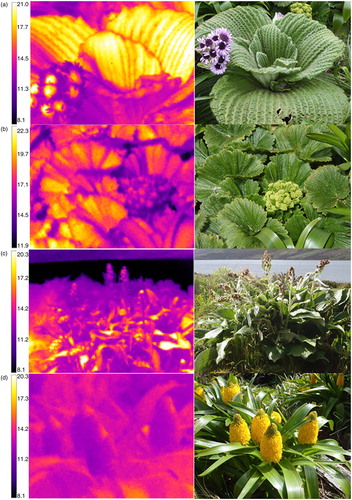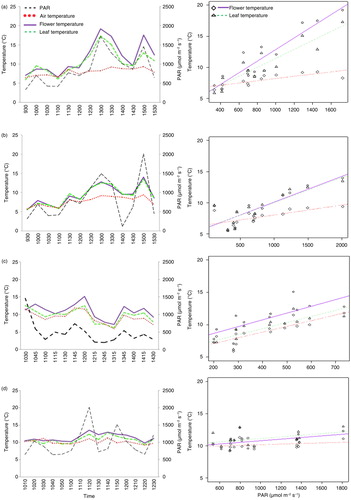Figures & data
Table 1 Locality and species descriptions of six megaherb species investigated for relations among plant structures, plant colours and temperature from Campbell Island. Leaf and floral characteristics follow descriptions by Allan (Citation1982) and Moore & Edgar (Citation1976).
Table 2 Six megaherb species from Campbell Island investigated by thermal imaging. N indicates number of thermal images collected from different plants, except for Pleurophyllum speciosum and P. hookeri, which had multiple images taken of the same plant. Mean ambient temperatures and mean minimum and maximum inflorescence temperatures registered in thermal images are given±standard deviation. Significance levels between mean ambient temperature and mean inflorescence temperatures were tested by paired t-tests (***P<0.001, *P<0.01, *P<0.05). Floral heating effects are given as mean maximum increases in flower temperature above the simultaneously measured air temperature±standard deviation.
Fig. 1 Thermal images (left) and corresponding digital images (right) of the megaherb species included in time-course measurements. (a) Pleurophyllum speciosum, (b) Stilbocarpa polaris, (c) Pleurophyllum criniferum, (d) Bulbinella rossii.

Table 3 Summary of floral and leaf heating effects of four megaherb species measured by thermal probe measurements at Campbell Island. One plant per species was measured over time. N indicates number of thermal measurements per plant. Floral and leaf heating effects are given as mean increases in inflorescence and leaf temperature above the simultaneously measured air temperature. Significant difference tested by paired t-tests (***P<0.001, **P<0.01, *P<0.05).
Fig. 2 Time courses (left) and linear model regression (right) of time-course data displaying relationship between inflorescence temperature, leaf temperature, air temperature and PAR in megaherb species for (a) Pleurophyllum speciosum, (b) Stilbocarpa polaris, (c) Pleurophyllum criniferum and (d) Bulbinella rossii. Linear model regression (right) of time-course data displaying relationship between flower temperature and PAR in megaherb species. Only (a) P. speciosum and (b) S. polaris were measured on the same day ().

